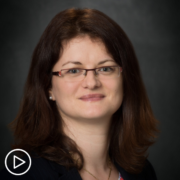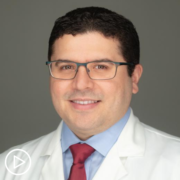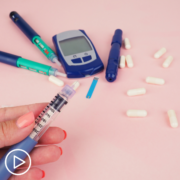Follicular Lymphoma Patient Expert Q&A: Start Here from Patient Empowerment Network on Vimeo.
The START HERE program bridges lymphoma expert and patient voice, whether you are newly diagnosed, in active treatment or in watch and wait. In this webinar, Dr. Sameh Gaballa provides an overview of the latest in follicular lymphoma, emerging therapies, clinical trials and options for follicular lymphoma progression and recurrence.
Dr. Sameh Gaballa is a hematologist/oncologist specializing in treating lymphoid malignancies from Moffitt Cancer Center. Learn more about Dr. Gaballa.
Download Resource Guide | Descargar guía de recursos
See More from START HERE Follicular Lymphoma
Related Resources:
Transcript:
Lisa Hatfield:
Welcome to the START HERE Patient Empowerment Network Program. This program bridges the expert and patient voice enabling patients and care partners to feel comfortable asking questions of their healthcare team. Joining me today is Dr. Sameh Gaballa, an oncologist hematologist from Moffitt Cancer Center. Dr. Gaballa’s clinical interests are treating patients with lymphoid malignancies. His research focuses on developing novel targeted agents for treating patients with indolent lymphomas, such as follicular lymphoma, marginal zone lymphoma, and lymphoplasmacytic lymphomas. Thank you so much for joining us today, Dr. Gaballa.
Dr. Sameh Gaballa:
Thank you, Lisa. Happy to be here.
Lisa Hatfield:
Thank you. The world is complicated, but understanding your follicular lymphoma diagnosis and treatment options doesn’t have to be. The goal of START HERE is to create actionable pathways for getting the most out of follicular lymphoma treatment and survivorship.
Before we get started, please remember to download the program resource guide via the QR code. There’s great information there that will be useful during this program and after. So let’s get started. So, Dr. Gaballa, I’d like to talk about what’s on the follicular lymphoma treatment radar. There’s a lot going on in terms of emerging treatment options, clinical trial data, and other learnings for the follicular lymphoma community. But before we jump into how the armamentarium is expanding, can you provide an explanation of what follicular lymphoma is?
Dr. Sameh Gaballa:
Yeah, absolutely, thank you, Lisa. So, follicular lymphoma is a type of B-cell non-Hodgkin’s lymphoma. What does that mean? It’s basically, so in your body, there are cells that are part of the immune system; these are lymphocytes. These cells normally, their normal function, is to fight infection, they’re part of your immune system. They actually are involved also with fighting cancers, but sometimes they become malignant. But not all lymphomas are the same. Lymphomas are a huge family. So there’s Hodgkin’s lymphoma, there is non-Hodgkin’s lymphoma. Within non-Hodgkin’s lymphoma, there is a type called B-cell non-Hodgkin’s and there’s a T-cell non-Hodgkin’s lymphoma. And then within B-cell non-Hodgkin’s lymphoma, there are two big groups. So one group, they are these aggressive lymphomas that grow quickly, they can make you sick quickly, and these lymphomas we have to treat right away.
And then you have those slow-growing indolent lymphomas that are sometimes very commonly actually diagnosed by chance, or incidentally, that’s usually the most common way these are diagnosed. And the most common slow-growing indolent lymphoma is going to be follicular lymphoma. Now, where do you find these lymphomas? It’s a blood disease. So, again, we said that those cells are normally borne in the bone marrow, they are in the blood, they’re in the lymph nodes, they’re in the spleen. So usually you would find those malignant cells usually in the lymph nodes, but you could also find them sometimes in the spleen or in the blood or in the bone marrow as well. And the symptoms they cause will be dependent on where they are and how big the, those, the involvement is.
Lisa Hatfield:
Well, thank you for that detailed overview, Dr. Gaballa. We do have follicular lymphoma patients and care partners who are newly diagnosed, in active treatment, watching and waiting, and also living with their disease joining this program. No matter where you are on your journey, START HERE provides easy-to-understand, reliable, and digestible information to help you make informed decisions. Dr. Gaballa, we’re going to dive right into things with a high-level update. So, can you speak to the novel pathways and targets that are currently under investigation in follicular lymphoma? And what are the most important highlights to point out to patients and families?
Dr. Sameh Gaballa:
Yeah, absolutely. So you have to remember, number one, not all patients with follicular lymphoma have to be treated. A fair number of patients can be safely observed initially, because the…so when I was talking about the types of lymphoma, so the aggressive lymphomas, those ones are treatable, but curable, meaning you treat it, goes away, good chance that it goes away and does not come back. Whereas follicular lymphoma, those are slow-growing lymphomas. They may or may not cause problems. The treatment though, they’re very treatable. There are a lot of treatments available, but the thing is they’re not curable, meaning that they go into remission, they could stay in remission for years, but then eventually they would come back again. So you have to remember that because of that, large trials were done previously where patients who had no symptoms and not a lot of disease, they were randomized, half would get treated.
The other half were on a watch and wait. And the patients who, survival is exactly the same in both groups, there was not really any advantage to early treatment versus treatment as if there’s a reason in the future. And we typically have some indications where we decide, okay, well, it’s time to treat. And those basically have to do if the lymph nodes are big enough or they’re close to an important structure and we don’t want them to grow more and maybe press on an important structure, or if they’re causing some kind of symptom or they’re causing anemia or low platelets. I mean, there has to be one, because there has to be one reason for why you’re trying to treat that patient, because you’re basically trying to fix a problem.
So if there’s no problem initially, it doesn’t make sense to treat it. Now, there are lots of available treatments, it could be only immune therapy, something like rituximab (Rituxan) or obinutuzumab (Gazyva); these are antibody treatments. There are also combinations with chemotherapies, like bendamustine (Treanda), rituximab for if we have relatively bulky disease. There are options as well that do not involve chemotherapy.
So something like pills like lenalidomide (Revlimid) combined with rituximab, those are also options that can be used in follicular lymphoma. But over the last few years, there have been a lot of changes in follicular lymphoma and a lot of novel targets and a lot of novel treatments available. So, for example, a few years ago now, we’ve had CAR T-cell therapy approved. Right now, we have two products approved, axi-cel and tisagenlecleucel (Kymriah). There’s also data that was presented with liso-cel in follicular lymphoma. So hopefully we might see an approval for that as well. So that’s one class.
There’s also bispecific antibodies, and it’s very exciting times. We had the first bispecific antibody approved in the United States in December of 2022. That’s mosunetuzumab (Lunsumio). So what is a BiTE antibody? These basically are advanced types of immune therapies where you give the patient an antibody that has two ends to it, one end sticks to the cancer cell, the other end sticks to your immune cells. So it’s basically , it’s handholding your own immune cells or your own T cells to go and get attached to the cancer cell and kill it, not chemotherapy. It, of course, can have some immunological side effects like fevers or inflammation initially when it’s done, typically when in the first cycle or second cycle.
But something called cytokine release syndrome rarely can cause neurological toxicity. That’s also very transient usually, and very rare with bispecific antibodies. But those are two up and coming treatments. Right now, they’re approved in patients who’ve had relapsed/refractory disease, meaning they’ve had two or more lines of previous therapies, but they’re…we have them now in trials where we’re looking at those agents in earlier lines of therapy. There are other agents as well.
A few years ago we had tazemetostat (Tazverik) approved, which is a pill that targets an enzyme in the cells called EZH2 and they basically, this pill tries to ask the cancer cell to differentiate, rather than get stuck and not die. So they differentiate and then they eventually die, so that’s another class of medicine. And we’ve now seen some data with BTK inhibitors. There’s been data presented from the ROSEWOOD Study with zanubrutinib plus obinutuzumab (Brukinsa plus Gazyva); it’s not yet FDA-approved, but the data looks interesting and certainly needs to be looked at further.
Lisa Hatfield:
Well, thank you for that overview. It seems like as a blood cancer patient myself, it seems like a hopeful time for patients with the treatments that are kind of on the horizon or are in clinical trials right now. So thank you for that.
Dr. Sameh Gaballa:
Absolutely.
Lisa Hatfield:
So it’s that time now where we answer questions, some of which we’ve received from you, the patients watching this. Remember, as patients, we should always feel empowered to ask our healthcare providers any and all questions we might have about our treatment and prognosis. Please remember, however, that this program is not a substitute for medical care. Always consult with your medical team. So, Dr. Gaballa, let’s start here. How do you explain follicular lymphoma treatment options and prognosis to your newly diagnosed patients? And what does shared decision-making look like in your office?
Dr. Sameh Gaballa:
Oh, absolutely. So follicular lymphoma, you really have to explain to the patient what, how are we coming to the recommendation that we’re currently giving. So if we think this is, this patient is a good candidate for a watch-and-wait approach, for example, we really have to walk them through why that really is the best option and not why should we jump on treatments and vice versa, if we think this patient needs to be treated, how do we really…the patient really has to understand all the other treatment options and why this needs to be treated. Because a lot of patients initially, sometimes when you present them with a watch-and-wait approach, if they don’t know all the background, they might not feel very comfortable because they might think, “Well, I have this cancer in me, and we’re not doing anything about it, and that doesn’t really sound too…something I should be doing.”
But then when you explain to them, “Well, you see, you don’t have a lot of disease, those studies have already been done in the past where patients who were treated or not treated, the survival was the same, so there, you might get side effects from the treatment, but not necessarily have benefits. And in the future, should this need to be treated, we have a lot of things to do.” So, really, so this is kind of the shared decision portion where you just have to walk the patients through why that will be the best situation. There is data with single-agent rituximab, even in patients who are asymptomatic, and we have the UK data, and that’s an option.
And that is also offered to some of the patients, even if they’re not symptomatic and they don’t have a lot of disease, if that’s what really the patient wants, if they’re not really comfortable with a watch and wait. And there’s again some data to help justify that. Again, there’s no advantage in overall survival, but sometimes the patients would kind of feel more in control. They feel like, “Okay, I did something about it.” So that’s the shared approach.
In terms of your other question about prognosis, unfortunately that’s an area of an unmet need. I mean, we have some tools to help us differentiate follicular lymphoma patients from each other, which patient is high-risk, meaning those are the patients who might relapse quickly, or they might not respond well to treatments. Unfortunately, we don’t have great tools. We have something called a FLIPI score, which is, we use a number of parameters including clinical parameters like stage or age and some other parameters as well, and we have a scoring system. But it doesn’t 100 percent predict if this is going to be a high-risk follicular lymphoma or a low-risk.
Unfortunately, the best predictor of prognosis for follicular lymphoma, you would know about retrospectively, it’s something called POD24, progression of disease in 24 months. Meaning that if you have a patient who’s treated with chemotherapy and immune therapy, and then they go into remission, and then they relapse again in less than 24 months, progression of disease within 24 months, those are the, those represent about 20 percent of follicular lymphoma patients, and those represent a high-risk group of patients. That’s the best tool that we have. But unfortunately, if you’re diagnosed today, you’re not going to know if you’re in this group or not until you actually need to be treated and not just treated with immune therapy.
It has to be with chemotherapy as well. And then if you relapse within two years, then we know that this is a high-risk entity. There is genetic testing, there is something called a FLIPI-m7 scoring system. But again, these tools are not great to tease out the low risk from the high-risk follicular lymphoma patients. But 80 percent of patients who are not going to be POD24, meaning that they get treated, they’re in remission for two years or more, and actually those patients have very similar survival to the general population. So, yeah, so a lot of times we don’t know right away, but we do have some tools to kind of give us an idea.
Lisa Hatfield:
Great. Thank you for that information. It’s kind of hard for cancer patients to only know what their prognosis is retrospectively, but that’s a great explanation. Thank you. Okay, another patient question, “How does the staging of follicular lymphoma impact treatment choices?”
Dr. Sameh Gaballa:
Yeah, so as you saw, I didn’t really stress too much about staging, because it’s a blood disease. So the vast majority of patients are going to be what we call stage III to IV disease. So, obviously when you see a patient if if they, they might think that, “Oh my God, I have a stage III to IV cancer,” because that’s really what they’re familiar with. But follicular lymphoma is a blood disease, so by default it’s going to be in a lot of lymph nodes, it might be in the bone marrow as well, but stage III to IV disease follicular lymphoma doesn’t, that does not mean that this is a terminal cancer. Patients could live completely in normal life, even with a stage III to IV follicular lymphoma. This is not like a breast cancer or colon cancer where stage is everything.
But why do we have a staging system? Obviously, there’s a need to have staging system for all cancers, but clinically, the only time it makes a difference is there’s a small group of patients who have a truly stage I or II disease, meaning just one group of lymph nodes on one side of the diaphragm that may fit within one radiation field. So if you have someone who’s just coming in with one or a few groups of lymph nodes all in one place, we call that a stage I or II follicular lymphoma, not common, because again, most patients are stage III to IV. The only difference there is you can potentially offer those patients radiation therapy if it’s truly localized, but then you would need to do a bone marrow biopsy and confirm that it’s not in the bone marrow.
And if it is localized within one radiation field, that can be offered and we can sometimes give after radiation therapy, either observe it or consider giving rituximab afterwards. But that’s the only time where we’re going to mention staging, again, uncommon because most, the vast majority of patients are going to be stage III to IV. So why would we do that? Why would we irradiate if it’s only one group of lymph nodes? Because there’s about, I mean, if you irradiated, those lymph nodes will go away, but there’s about maybe a, it’s different. The number is different between studies, but about maybe a third of patients, if you irradiate that group of lymph nodes or one lymph node, it actually might not come again in the future. So you might have very long remissions/possible cure if you…and this is the only situation where we would consider treating someone who does not have symptoms, because you could have very long remissions with radiation.
Lisa Hatfield:
Although follicular lymphoma is a slow-growing cancer, can you speak to the signs that the disease is progressing in the body, what signs that patients might want to look out for?
Dr. Sameh Gaballa:
Yeah, absolutely. So, typically we educate the patients to there are some red flags to look out for, not just for progression,but also for another condition called disease transformation. So, follicular lymphoma does have a, there is a possibility that it can transform from a slow-growing lymphoma to an aggressive lymphoma. Now, this happens at a rate of about maybe 2 to 3 percent per year, but it’s a cumulative risk, so meaning if a patient lives many, many decades, their lifetime risk can be up to as high as 20, 25 percent, 30 percent, depending on the different literature, so there is a chance that these slow-growing lymphomas can transform to an aggressive lymphoma.
And when they do know this, there’s no watch and wait for transformed disease. It has to be treated with chemo immunotherapy because the goal of treatment then is to try to get rid of the aggressive component. What are the signs and symptoms to suggest that you might have transformed disease? This is not something that the patient would typically need to look out for. I tell my patients that, “You don’t need to see, do I have transformed disease or not. This is going to come, and you’re going to know when you have transformed disease. Extreme fatigue, drenching night sweats, the fever sometimes that are not going away.”
The patient might have pain if the lymph node is pressing on some important structure. They may have loss of appetite, loss of weight. So again, something that dramatically happens quickly over a few weeks of time. So if the patient feels sick for one reason or another and they’re not getting better, it can all happen within a few weeks’ time frame. This is the time to get checked early on and go see your oncologist, because then we might need to investigate if there is any potential for transformation. So that’s issue number one.
Issue number two is, which is the much more common scenario, which is the follicular lymphoma is slowly progressing. How would you know? I mean, if you notice a lymph node that in your neck or under the armpits or the groin areas, if they’re growing, then that needs to be evaluated. I mean the patients should expect that those will be growing, they will grow. But they grow over months and years. They don’t grow over weeks.
So anytime you kind of are unsure, if you feel that it’s growing faster than usual, this is, again, something to look out for. And then the B symptoms that I mentioned. So like the sweats, the fevers, the weight, loss of weight, loss of appetite, these are also sometimes things to look out for. Not necessarily, they don’t always mean that it’s transformed disease. It can also be that the follicular lymphoma is also progressing and might need to be treated as well.
Lisa Hatfield:
And then just a quick follow-up to that question. So a patient is watching out for these red flags, but are they going through any kind of regular monitoring in your office? Are you meeting with them on a regular basis? And how frequent might that be for a follicular lymphoma patient who’s watching and waiting?
Dr. Sameh Gaballa:
Yeah. So how does watch and wait look? So, and I tell patients always watch and wait does not mean ignore. Watch and wait means that we’re monitoring the disease, we’re looking at it. How do we do that? So typically we would see the patient maybe every three to six months. And then depending on how do we, when we get a sense or tempo of how their disease is progressing, then we’ll know how often we need to see them. I’ve had, I still have patients where I’m seeing them every three months. And I also have some patients where the disease has been stable for years, I only see them once a year.
In terms of imaging, that’s also sometimes an area of controversy. Typically, initially for the first maybe year or two years, I do like a scan, like a CT scan every six months, just to get a sense of how quick or how slow the disease is progressing. If there’s absolutely no change at all, then sometimes we either don’t do scans and just go by the patient’s symptoms and blood work and physical exam, or we do maybe once a year scan but not more than that. So this is how we would monitor the patients in a watch-and-wait approach.
Lisa Hatfield:
And we have another question about treatment profiles, “What can I do to reduce side effects during active treatment?”
Dr. Sameh Gaballa:
So it depends on what the treatment that you’re getting. If it’s immune therapy, like rituximab alone, those typically don’t really have a lot of side effects. I mean, sometimes with the first one or two treatments, you might get an allergic reaction, an infusion allergic reaction, which is very common, but subsequently it shouldn’t really cause a lot of side effects. If the patient is getting chemotherapy, well, it depends on which chemotherapy they’re getting. But in general, it’s always good to stay hydrated and to stay physically active. So if the patient goes in with a healthy body, well-hydrated, you eat fresh fruits and vegetables, walking 30 to 60 minutes a day, your body is going to handle the side effects much better than if you’re going in, you’re very weak, and your general health is not adequate.
Lisa Hatfield:
Another patient is asking if you can speak to emerging treatment options for patients with relapsed/refractory follicular lymphoma?
Dr. Sameh Gaballa:
Yeah. So the field of follicular lymphoma is changing rapidly. I always tell patients that sometimes the best treatment is actually on a clinical trial because those are going to be the next generation of treatments that are going to get approved in the next few years. But right now we have the most effective therapy really is CAR T-cell therapy. CAR T-cell therapy by far is the most effective treatment we have at this time. It’s approved for patients who have had two or more lines of prior therapies. We also are investigating this.
I actually have a trial here at Moffitt where we’re looking at CAR T-cell therapy as early as in the second line, in patients who have what we call the high-risk ones, the POD24. So a patient with POD24 follicular lymphoma relapsed in less than two years. We have a trial to investigate the role of CAR T-cell therapy in this setting. The other very promising group of treatments, again, is bispecific antibodies, again, currently approved in the third line, mosunetuzumab.
But there are others coming up and have data on epcoritamab-bysp (Epkinly), as well as a lot of other bispecifics, as well as combinations. I mean, epcoritamab-bysp has also data presented with combination with lenalidomide. And right now, the follow-up duration is not very long, but so far, it looks extremely promising with very high response rates. So those also might be coming very soon. And, of course, once something works in the relapsed/refractory setting, we start looking at earlier lines of therapy.
And actually, we’re now looking at trials in the first-line setting with some of these agents as well. Tazemetostat is a pill. It’s also approved in the third-line setting, but we’re also investigating it. We have a trial here where we’re looking at combining it with standard rituximab, lenalidomide, so tazemetostat plus rituximab, lenalidomide as early as in the second line. So that also is interesting. And as I mentioned before, BTK inhibitors currently being looked at in trials might also have a role in follicular lymphoma very soon.
Lisa Hatfield:
And this patient is asking about the significance of bispecific antibody treatment. And you touched on that a little bit. It looks like she’s also asking if there are specific genetic or molecular markers that can predict a patient’s response. And if I try to translate that, maybe she might be asking about targeted therapy.
Dr. Sameh Gaballa:
Yeah, so bispecific antibodies and CAR T-cell therapy, they target something called CD, either CD19 or CD20, and that’s almost universally expressed on B cells. So most of your follicular lymphoma patients are going to be expressing CD19 or CD20. Tazemetostat is the pill that I talked about. It inhibits an enzyme called EZH2. Some patients have an EZH2 mutation where it seems to work very well. However, tazemetostat also works in patients who don’t have that mutation. So that’s why it’s not very important to check for the mutation.
It seems maybe it works better in patients who do have the mutation, but it does work as well in patients who do not have that mutation. So unlike other malignancies and other cancers, biomarkers are not yet driving a lot of our treatment decisions in follicular lymphoma as of right now.
Lisa Hatfield:
Thank you. Another question. Is it common for follicular lymphoma to transform into a more aggressive type of lymphoma? And how would that change a treatment plan? And maybe how common is it for that to happen?
Dr. Sameh Gaballa:
Yeah. There’s about a 2 to 3 percent chance per year that the slow-growing lymphoma can transform to an aggressive lymphoma. That, if it does transform, I mean we talked about the symptoms and signs, you get sick quickly, rapidly enlarging lymph nodes, loss of weight, loss of appetite, drenching night sweats. No, a transformation, typically we would do a PET scan, see what’s the most active lymph node, try to get a biopsy from that and confirm there is a large cell transformation. Now, that’s a completely different disease, it needs to be treated completely differently, typically with chemoimmunotherapy.
Something like R-CHOP, for example, is one of the most common regimens we use in this scenario. And the goal of treatment here is to try to get rid of the aggressive lymphoma component here so that it does not recur again. I mentioned it’s about a 2 to 3 percent per year, but it depends on how long the patient lives. So if they live many, many, many decades, their lifetime risk is anywhere between 20 to 30 percent max during their lifetime.
Lisa Hatfield:
And As a blood cancer patient myself, this is a great question this patient is asking, “Is there a risk of secondary cancers after receiving treatment for follicular lymphoma?”
Dr. Sameh Gaballa:
So that’s always a concern, and it depends on what treatment they had. So chemotherapy that can potentially damage DNA can lead to second malignancies, including things like acute leukemia. Luckily, that’s not a high risk. That’s a rare side effect from some of those chemotherapies. Some of the pills can do that as well. Something like lenalidomide can sometimes have second malignancies. But we’re talking about rare incidences, and the benefits usually would outweigh the risks. But it’s not with all treatments, meaning some of the other immune therapies that do not involve chemotherapy would not typically be associated with some of those second malignancies. So it just really depends on what exactly the treatment you’re getting.
Lisa Hatfield:
Can you speak to maintenance therapy and monitoring in follicular lymphoma? And what signs of infection should patients and care partners be aware of during treatment?
Dr. Sameh Gaballa:
Yeah, so there have been randomized studies in slow-growing lymphomas that show that if you do, after you get your standard treatment for follicular lymphoma, if you do what we call a maintenance treatment, usually with rituximab, which is an immune therapy, where you do it every two to three months for about two years, we have data showing that that decreases or delays the risk of relapse. However, it doesn’t change the overall survival, meaning that it just has patients in remission longer. When their disease comes back, they just get treated again at that point, and it doesn’t really affect survival.
So it’s one of those shared decision-making with the patients. I usually go over the risks and benefits of maintenance therapy. It’s optional. It’s not a must. During COVID, we pretty much stopped all maintenance treatments, because the risks were outweighing the benefits because maintenance treatment is…will suppress the immune system more, is associated with more infections. And these infections can be anything. I mean, it could be a pneumonia, could be recurrent urinary infections. It could be any type of infection. So there’s always this risk and benefit that we have to discuss with the patient.
Lisa Hatfield:
Well, Dr. Gaballa, thank you so much for being part of this Patient Empowerment Network START HERE program. It’s these conversations that help patients truly empower themselves along their treatment journey. And on behalf of patients like myself and those watching, thank you so much for joining us, Dr. Gaballa.
Dr. Sameh Gaballa:
No, thank you, Lisa. I really appreciate it. Thank you.
Lisa Hatfield:
I’m Lisa Hatfield. Thank you for joining this Patient Empowerment Network program.
Share Your Feedback:
Create your own user feedback survey













